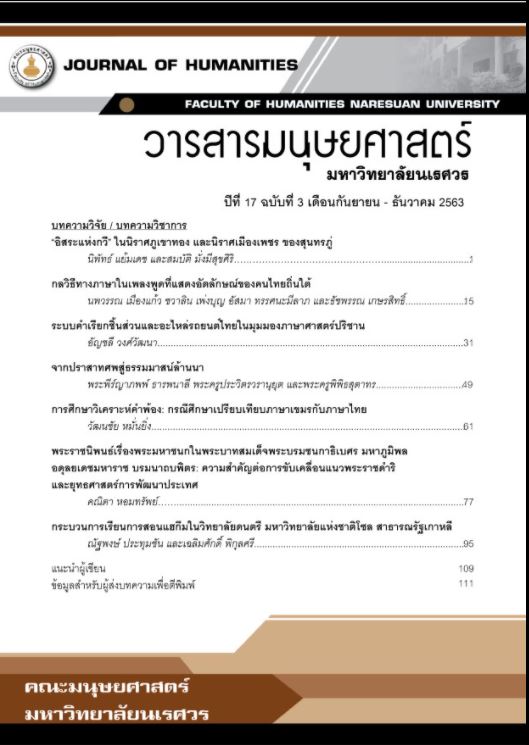ระบบคำเรียกชิ้นส่วนและอะไหล่รถยนต์ไทยในมุมมองภาษาศาสตร์ปริชาน
Main Article Content
บทคัดย่อ
งานวิจัยนี้มีวัตถุประสงค์เพื่อศึกษากลวิธีไวยากรณ์การสร้างคำเรียกชิ้นส่วนและอะไหล่รถยนต์ อรรถศาสตร์หมวดหมู่คำเรียก และความสัมพันธ์ระหว่างคำเรียกและโลกทัศน์และวัฒนธรรมไทย ข้อมูลได้จากทั้งตัวบทที่ปรากฏใช้และจากการซักข้อมูล การวิเคราะห์อาศัยกรอบแนวคิดทางภาษาศาสตร์ปริชาน ผลการวิจัยพบว่าไวยากรณ์คำเรียกแสดงหน้าที่การสื่อสารและวากยสัมพันธ์ที่หลากหลาย อรรถศาสตร์คำเรียกมี 2 ชนิดหลักคือเชิงประสมสร้างที่มีความหมายที่โปร่งใสและเชิงจินตภาพที่แสดงความหมาย 3 ประเภทได้แก่ ความหมายอุปลักษณ์ แสดงสิ่งของ มนุษย์ สัตว์ และพืช ความหมายนามนัย แสดงหน้าที่ ตำแหน่ง รูปทรง วัสดุ และอวัยวะที่เกี่ยวข้อง และความหมายค้านนามนัย ใช้เมื่อชิ้นส่วนและอะไหล่รถยนต์ยากต่อการระบุ และหมวดหมู่นี้สะท้อนสิ่งต่างๆ ที่แวดล้อม ระบบคิด และวิธีที่คนไทยเชื่อมโยงชิ้นส่วนและอะไหล่รถยนต์กับสิ่งอื่นๆ
Article Details
ข้อความรู้ใด ๆ ตลอดจนข้อคิดเห็นใด ๆ เป็นของผู้เขียนแต่ละท่านโดยเฉพาะ คณะมนุษยศาสตร์ มหาวิทยาลัยนเรศวร และกองบรรณาธิการวารสารมนุษยศาสตร์ฯ ไม่จำเป็นต้องเห็นพ้องด้วย
เอกสารอ้างอิง
เทคนิคคาร์.คอม “เจาะลึกเกี่ยวกับอะไหล่รถยนต์”. สืบค้นเมื่อ 17 มกราคม 2562. จาก http://www.techniccar.com
ราชบัณฑิตยสภา. (2550). พจนานุกรมศัพท์ยานยนต์และเครื่องยนต์ ฉบับราชบัณฑิตยสถาน. กรุงเทพฯ: ราชบัณฑิตยสถาน.
ราชบัณฑิตยสถาน. (2550). พจนานุกรมศัพท์ยานยนต์และเครื่องยนต์ อังกฤษ-ไทย ฉบับราชบัณฑิตยสถาน. กรุงเทพฯ: ราชบัณฑิตยสถาน.
วัลลภ มากมี. (2556). ช่างยนต์. สืบค้นเมื่อ 4 มกราคม 2562. จาก https://vallop-automechanics. blogspot.com.
อัญชลี สิงห์น้อย วงศ์วัฒนา และสุพัตรา จิรนันทนาภรณ์. (2556). การศึกษาคำเรียกชื่อพืชในภาษากลุ่มชาติพันธุ์ไทในเขตภาคเหนือ. วารสารมหาวิทยาลัยนเรศวร, 21(1), 72-92.
อัญชลี สิงห์น้อย วงศ์วัฒนา. (2555). ชุดกริยาในภาษาไทย: กริยาเรียงหรืออื่นใด. วารสารภาษาและวัฒนธรรม, 31(2), 36-61. กรุงเทพฯ: มหาวิทยาลัยมหิดล.
อัญชลี สิงห์น้อย วงศ์วัฒนา. (2557). คำเรียกชื่อพืชแบบพื้นบ้านไทย : การศึกษาเชิงภาษาศาสตร์พฤกษศาสตร์ชาติพันธุ์. กรุงเทพฯ: สำนักพิมพ์แห่งจุฬาลงกรณ์มหาวิทยาลัย.
อัญชลี สิงห์น้อย วงศ์วัฒนา. (2559). คำบ่งกลุ่มนาม. วารสารสงขลานครินทร์ (ฉบับสังคมศาสตร์และมนุษยศาสตร์), 22(2), 91-122.
อัญชลี สิงห์น้อย วงศ์วัฒนา. (2560). ชื่อพืช โลกทัศน์ และภูมิปัญญาไทครั่งภูมิภาคเหนือตอนล่าง. วารสารอารยธรรมศึกษา โขง-สาละวิน, 8(1), 261-286.
อะไหล่รถยนต์ออนไลน์. สืบค้นเมื่อ 7 มกราคม 2562. จาก http://caronlineparts.com
Bauer, Laurie. (1983). English Word-Formation. Cambridge Textbooks in Linguistics. Cambridge, UK: Cambridge University Press.
Bauer, Laurie. (1992). Lexicalization and level ordering. Linguistics, 30, 561-568.
Brintion, Laurel J. and Traugott, Elizabeth C. (2005). Lexicalization and Language Change. (Research surveys in linguistics). Cambridge: Cambridge University Press.
Brown, Roger. (1958). How shall a thing be called? Psychological Review, 65, 14-21.
Downing, Pamela. (1977). On the creation and use of English nominal compounds. Language, 810-842.
Fillmore, Charles. (1982b). Frame semantics.In Linguistic Society of Korea (ed.). Linguistics in the Morning Calm, 11-38.
Givón, Talmy. (2001). Syntax Vol.I,II. Amsterdam, the Netherlands and Philadelphia, USA: John Benjamins Publishing Company.
Kay, Paul and Mcdaniel, Chad K. (1978). The Linguistic Significance of the Meanings of Basic Color Terms. Language, 54, 610-46.
Lakoff, George and Johnson, Mark. (1980). Metaphor We Live By. Chicago: University of Chicago Press.
Lakoff, George. (1987). Women, Fire, and Dangerous Things: What Categories Reveal about the Mind. Chicago and London: The University of Chicago Press.
Lakoff, George. (1995). “Women, fire, and dangerous things” The importance of Categorization. Chicageo: The University of Chicago Press.
Lambrecht, Knud. (1994). Information Structure and Sentence Form: Topic, Focus and the Mental Representations of Discourse Referents. Cambridge: Cambridge University Press.
Levi, Judith N. (1978). The Syntax and Semantics of Complex Nominals. New York: Academic Press.
Rosch, Eleanor, Simpson, Charles and Miller, Robert C. (1976). Structural Bases of Typicality Effects. Journal of Experimental Psychology: Human Perception and Performance, 2, 491-502.
Rosch, Eleanor. (1973). Natural Categories. Cognitive Psychology, 4, 328-350.
Rosch, Eleanor. (1977). Human categorization. In Warren, N. (ed.), Studies in Cross-cultural Psychology, (pp. 1-49). London: Academic.
Rosch, Eleanor. (1978). Principles of categorization. In Rosch and Lloyd (eds.), Cognition and Categorization, 27-48.
Ryder, Mary Ellen. (1999). Comples -er nominals: Where grammaticalization and lexicalization meet? In Ellen Contini-Morava and Yishai Tobin, (eds.), Between Grammar and Lexicon, (pp. 291-147). Amsterdam and Philadelphia: John Benjamins.
Saleh and Wongwattana. (2019). Linguistic Characteristics of Village Typonyms in Yala Province: An Analysis of Functional-Typological Grammar. PSAKU International Journal of Interdisciplinary Research, 18(1), 48-92.
Selkirk, Elisabeth O. (1982). The Syntax of Words. Cambridge, Massachusetts: The MIT Press.
Wongwattana, Unchalee S. (2011). A reflection of Thai culture in Thai plant names. Manusya: Journal of Humanities, 14(1), 79-97.
Wongwattana, Unchalee S. (2016). Word Compounding in Tai Dam: A Reflection of People World View and Culture. Journal of Mekong Societies, 12(2), 103-136.
Wongwattana, Unchalee S. (2018). Syntactic compound words in Tai Krang. MANUSYA: Journal of Humanities, 21(1), 106-121.


